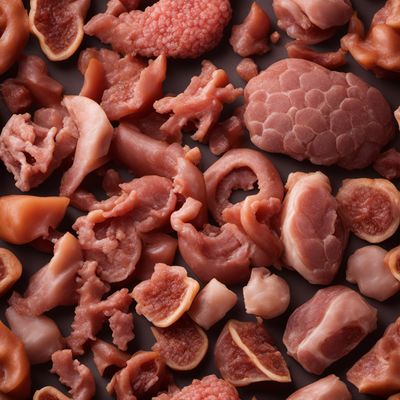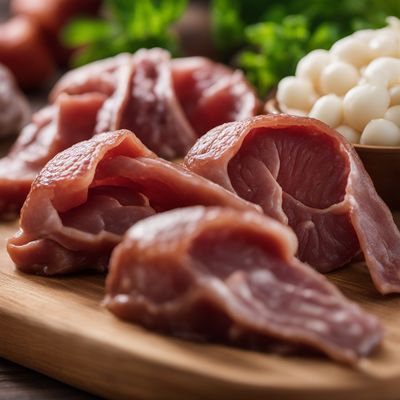
Ingredient
Goat edible offal, non-muscle, other than liver and kidney
The Hidden Gems of Goat: Exploring the Delicacies of Edible Offal
Goat edible offal refers to the internal organs and entrails of the goat, including the heart, liver, kidneys, sweetbreads, and tripe. These cuts are known for their distinct flavors and textures. The heart is tender and lean, while the liver has a rich, earthy taste. Kidneys have a slightly gamey flavor, and sweetbreads are prized for their delicate, creamy texture. Tripe, the lining of the stomach, has a chewy consistency. These offal cuts can vary in color and appearance, with the liver being deep reddish-brown and the kidneys having a smooth, pale surface.
Origins and history
The consumption of goat edible offal dates back centuries and is deeply rooted in various culinary traditions around the world. In many cultures, offal is highly valued for its nutritional benefits and is considered a delicacy. Goat offal is particularly popular in Middle Eastern, African, and Caribbean cuisines, where it is used in traditional dishes such as Moroccan tagines, Nigerian pepper soup, and Jamaican curries.
Nutritional information
Goat edible offal is a nutritional powerhouse, packed with essential vitamins and minerals. It is a great source of protein, iron, zinc, and B vitamins. However, it is important to note that offal cuts can be high in cholesterol, so moderation is key.
How to select
When selecting goat edible offal, look for cuts that are fresh, firm, and free from any unpleasant odors. The color should be vibrant, and the surface should be smooth and moist. Avoid offal with discoloration or signs of spoilage.
Storage recommendations
Goat edible offal should be stored in the refrigerator at a temperature below 40°F (4°C). It is best to use it within 1-2 days of purchase to maintain its freshness and quality. If you plan to store it for longer, consider freezing the offal in airtight containers or freezer bags.
Preparation tips
Before cooking goat edible offal, it is important to properly clean and trim the cuts. Soaking the offal in cold water with a splash of vinegar or lemon juice can help remove any residual blood or impurities. Offal cuts can be prepared in various ways, including grilling, frying, braising, or incorporating them into stews and soups. Marinating the offal in flavorful spices or herbs can help enhance its taste. It is crucial to cook offal thoroughly to ensure food safety.
Substitutions
If goat edible offal is not available, beef or lamb offal can be used as substitutes. They offer similar flavors and textures.
Culinary uses
Goat edible offal is widely used in various cuisines. The heart can be grilled or used in stews, while the liver is often pan-fried or incorporated into pâtés. Kidneys can be sautéed or used in curries, and sweetbreads are commonly braised or fried. Tripe is often used in soups, stews, or as an ingredient in traditional dishes like menudo or haggis.
Availability
Goat edible offal is commonly available in regions where goat meat is consumed, such as the Middle East, Africa, and the Caribbean. It can also be found in specialty butcher shops or ethnic markets in other parts of the world.
More ingredients from this category

Sheep edible offal, non-muscle, other than liver and kidney
Exploring the Delicacies of Sheep Edible Offal

Pig edible offal, non-muscle, other than liver and kidney
Beyond the Ordinary: Exploring the Versatility of Pig Edible Offal

Wild boar edible offal, non-muscle, other than liver and kidney
Savory Treasures from the Wild

Camel edible offal, non-muscle, other than liver and kidney
Unveiling the Hidden Gems: Exploring the Exquisite Camel Edible Offal

Bovine edible offal, non-muscle, other than liver and kidney
The Hidden Gems of Bovine Offal

Rabbit edible offal, non-muscle, other than liver and kidney
Unveiling the Hidden Gems: Exploring the Versatile Rabbit Edible Offal

Deer edible offal, non-muscle, other than liver and kidney
The Hidden Gems of Deer: Exploring Non-Muscle Edible Offal

Equine edible offal, non-muscle, other than liver and kidney
Exploring the Hidden Gems of Equine Edible Offal